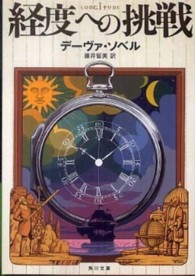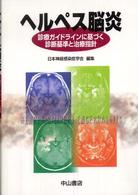- ホーム
- > 洋書
- > ドイツ書
- > Mathematics, Sciences & Technology
- > Earth Science
- > miscellaneous
Full Description
This book introduces a pathbreaking approach called 'Avoidable Disaster Deaths' (ADD) to reduce disaster deaths.
Disaster deaths are the direct and indirect impact of hazards. The 'Sendai Framework for Disaster Risk Reduction' has urged the United Nations Member States to reduce disaster deaths or mortality by 2030. Reducing the number of disaster deaths has become a useful marker for improving disaster risk management. Equally important is knowing how people die, who dies, why they die, and which disaster deaths are 'avoidable' and 'unavoidable'. Disaster risk reduction specialists have not fully examined these questions.
Built from disaster risk reduction, public health, epidemiology, human geography, risk and crisis management studies, the ADD approach disaggregates disaster deaths into avoidable and unavoidable. Avoidable disaster deaths are preventable, amenable and governance-related. Unavoidable deaths are those that occur annually due to natural causes or poverty-related diseases. In a disaster climate, the emphasis should be on reducing avoidable disaster deaths in a resource-constrained context.
Using the context of COVID-19 and the economic lockdown in India, the analytical advantage of this approach is explored. Doing so, the book brings forth human stories whose lives were cut short and introduces novel matrices and dynamic strategies to ascertain the 'cause and circumstances' of avoidable disaster deaths to develop the capacity of disaster and health responders.
The book is suitable for students, academics, policy-makers and practitioners interested in disaster risk reduction, human rights, risk and crisis management, environmental science, human geography, Sustainable Development and Sendai Goals.
The book is also suitable for passionate citizens who want to capture the number, causes and circumstances of avoidable disaster deaths and take positive action to save lives in their communities.
Professor Nibedita S. Ray-Bennett ably presents a novel 'avoidable disaster deaths' approach to disaster risk reduction and management by presenting cogent arguments rooted in solid theory and up to date literature reviews, complemented by a wealth of data and analysis from the Indian Covid 19 experience.
The book includes a range of tables and diagrams that crystallise approaches and practices useful for policy makers and practitioners alike. The book is highly informed, well written, accessible, practical and useful, with an optimal mix of strong, well-tested academic theory, and important recommendations that demand serious consideration by all involved and interested in disasters. A spur to action and inspiration.
(Professor Michael Petterson, School of Social Sciences, Auckland University of Technology, New Zealand)
Contents
Chapter 1. What is a Disaster?.- Chapter 2. What Leads to Disaster Disasters?.- Chapter 3. How Can Disaster Deaths be Reduced?.- Chapter 4. Unavoidable Deaths in India.- Chapter 5. Governance for COVID-19 in India.- Chapter 6. Avoidable Disaster Deaths in India.- Chapter 7. Avoidable Disaster Deaths Approach Revisited.- Index.
-

- 電子書籍
- あの夜は秘密【7分冊】 3巻 ハーレク…
-

- 和書
- 経度への挑戦 角川文庫






